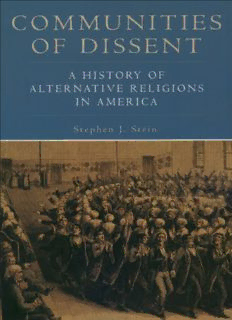
Communities of dissent : a history of alternative religions in America PDF
Preview Communities of dissent : a history of alternative religions in America
COMMUNITIES OF DISSENT COMMUNITIES OF DISSENT A History of Alternative Religions in America STEPHEN J. STEIN Oxford University Press Oxford New York Auckland Bangkok Buenos Aires Cape Town Chennai Dar es Salaam Delhi Hong Kong Istanbul Karachi Kolkata Kuala Lumpur Madrid Melbourne Mexico City Mumbai Nairobi São Paulo Shanghai Singapore Taipei Tokyo Toronto Copyright © 2000, 2003 by Stephen J. Stein Published by Oxford University Press, Inc. 198 Madison Avenue, New York, New York 10016 www.oup.com Oxford is a registered trademark of Oxford University Press All rights reserved. No part of this publication may be reproduced, stored in a retrieval system, or transmitted, in any form or by any means, electronic, mechanical, photocopying, recording, or otherwise, without the prior permission of Oxford University Press. Library of Congress Cataloging-in-Publication Data Stein, Stephen J., Communities of dissent : a history of alternative religions in America/ Stephen J. Stein. p. cm. Includes bibliographical references and index. ISBN 0-19-515825-3 (alk. paper) 1. Cults—United States—History. 2. Sects—United States—History. 3. United States—Religion. I. Title. BL2525 .S74 2002 291.9′0973—dc21 2002006219 9 8 7 6 5 4 3 2 1 Printed in the United States of America on acid-free paper On the cover: The Shakers of New Lebanon, New York, Religious Exercises in the Meeting-house by Joseph Becker. Frontispiece: Two Shaker sisters at Canterbury, New Hampshire, display their saxophones. Members of alternative religions do not always conform to uninformed stereotypes. These religious women obviously enjoy secular music. To many friends among members of alternative religions CONTENTS PREFACE INTRODUCTION: Talking About Religious Outsiders CHAPTER ONE Early Dissenters and Popular Religion CHAPTER TWO Peace Movements in Colonial America CHAPTER THREE Communitarians Living on the Margins CHAPTER FOUR Apocalyptic Traditions: Watching and Waiting for the End CHAPTER FIVE Healers and Occultists: Women of Spiritual Means CHAPTER SIX Sectarians in the City CHAPTER SEVEN Twentieth-Century Sects and Cults CHRONOLOGY FURTHER READING INDEX PREFACE The citizens of the founding generation of the United States dissented from English rule and boldly asserted their independence. The Declaration of Independence gave voice to the political aspirations of those who rebelled against a parliament that taxed colonists who had no representation in those proceedings. The U.S. Constitution, crafted after the turmoil of warfare and an era of political disunity, sought to secure peace and unity and to guarantee fundamental liberties, including the free exercise of religion. Dissent in a political context has been an honored tradition in America, and we celebrate the founders as patriots. But Americans have not uniformly celebrated communities of religious dissent, endorsed in the Constitution by the principle of the free exercise of religion. On the contrary, the public expression of religious dissent has often resulted in opposition. People, whose views or practices differ from dominant religious patterns in American society, frequently have been the target of ridicule, harassment, and persecution. Rarely have such religious dissenters been accorded the honor that Americans regularly heap upon political dissenters. The contrasting public images of the two different forms of dissent, political and religious, are evident in the simple juxtaposition of pairs of political and religious dissenters Thomas Paine and Ann Lee, Frederick Douglass and John Humphrey Noyes, Jane Addams and Mary Baker Eddy, Ralph Nader and David Koresh. American historians have widely Eddy, Ralph Nader and David Koresh. American historians have widely celebrated the first person in each of these pairs for his or her pioneering efforts on behalf of, respectively, political liberty, the abolition of slavery, assistance to the urban poor, and protection of the environment. The second half of each pair experienced bitter opposition: Lee was physically assaulted by angry mobs in several New England towns; Noyes was run out of the country by clergy, who hoped to bring him into criminal court; Eddy was the target of vilification by former students as well as lawyers and ministers; and Koresh was harassed by the government. Moreover, historians, looking back on the roles of these religious dissenters, have often failed to offer balanced accounts of their lives. Why have religious dissenters so often attracted the ire and hostility of others? What motivates those who attack such dissenters? What can we gain by learning more about the diverse communities of religious dissent that have been a part of American history from its earliest days? What role have these communities played in our national story, and what may we expect in the years ahead? The chapters that follow employ a variety of terms used to identify and define religious communities of dissent. Some of these terms, including “cult” and “sect,” have long traditions of use, stretching back to the centuries when Latin was the official language of scholars. But the meanings of words often change over time; and terms that once were neutral or simply descriptive sometimes take on harshly negative implications and potentially lose their original usefulness, including the two just mentioned. Other terms have been coined more recently to circumvent the stereotypes associated with older categories. Among this
Description: